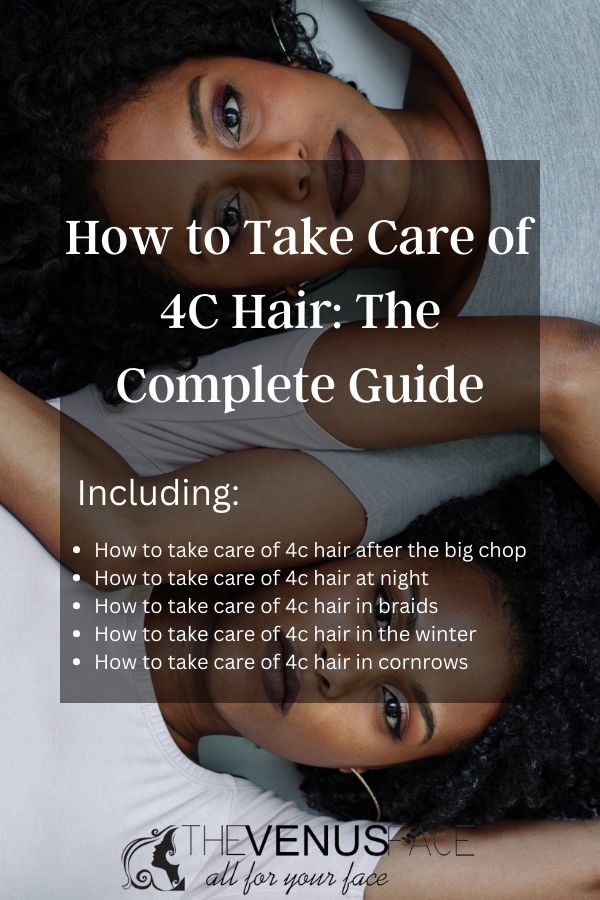4c hair is a type of Afro-textured hair that is characterized by its tightly curled coils. Unlike other curl patterns, 4c hair does not have a defined shape and can appear to be more “frizzy” or “kinky.” Although 4c hair is often thought of as being difficult to manage, it can actually be quite versatile. When properly cared for, 4c hair can be worn in a variety of styles, including braids, twists, and locs. In this blog post, we’ll share some tips on how to take care of 4c hair.
More: How to Soften Coarse 4C Hair With 10 Tips

How to take care of 4c hair daily
There are many reasons why people with 4c hair types should take care of their hair on a daily basis. One reason is that 4c hair is more prone to dryness than other hair types. This dryness can lead to breakage, which can be prevented by using a moisturizing shampoo and conditioner. In addition, daily detangling can help to prevent knots and tangles, which can also cause breakage. Another reason to take care of 4c hair is that it is more susceptible to damage from heat styling and chemical processing. Therefore, it is important to use heat protectants and limit the amount of heat styling and chemical processing that is done. By taking care of 4c hair on a daily basis, you can help to prevent dryness, breakage, and damage.
Here is a basic process on how to take care of 4c hair:
- Start by wetting your hair with cool or room-temperature water. This will help to reduce frizz and tangles.
- Apply a conditioner that is specifically designed for Afro-textured hair. Be sure to distribute the conditioner evenly throughout your hair, paying special attention to the ends.
- Use a wide-tooth comb to detangle your hair, starting from the ends and working your way up.
- If necessary, use a designated detangling product to help remove knots and tangles.
- Apply a moisturizing treatment to your hair, using a generous amount of product. Be sure to distribute the product evenly throughout your hair, paying special attention to the ends.
- Use a diffuser to dry your hair, or air dry it if possible. When drying, be sure to use a light touch and avoid rubbing your hair dry with a towel.
- Style your hair as desired using gel, mousse, or other styling products.
How to take care of 4c hair after the big chop
The big chop is a popular term used to describe the act of cutting off all chemically treated or heat-damaged hair in order to start fresh with a new, healthy hair journey. Many women who have 4c hair texture choose to do the big chop in order to achieve better results with their natural hair. There are several benefits to cutting off all damaged hair, including improved scalp health, reduced frizz and tangles, and increased length retention. In addition, the big chop can give you a much-needed confidence boost as you embrace your natural hair. Most of the time, after the big chop you may want to make it grow long as soon as possible. Here is a suggested hair care routine for those who have just done the big chop:
Wash your hair once a week
Washing your hair too often can strip it of its natural oils and lead to dryness, breakage, and scalp irritation. When you do wash your hair, be sure to use a gentle, sulfate-free shampoo and follow up with a good conditioner. If your scalp is particularly oily, you may want to consider using a clarifying shampoo once every two weeks to remove build-up.
More: How to Pre-poo 4C Hair in 6 Easy Steps
Deep condition regularly
Deep conditioning is an essential step in any 4c hair care routine. This helps to replenish moisture, strengthen the hair shaft and prevent breakage. aim to deep condition your hair at least once a week, using a quality conditioner and steaming your hair for best results.
Moisturize more often
After you get a haircut, your hair may feel odd at first. Depending on how much was cut off, your hair may have a completely different texture than before. Your scalp may also be more visible. All of these changes can be overwhelming, but don’t worry—this is all part of the process. One of the most important things you can do to care for your new look is to moisturize your hair regularly. Moisturizing 4c hair is especially important because this type of hair is prone to dryness. When you moisturize your hair, you help to keep it healthy and prevent breakage. There are many different ways to moisturize 4c hair, but one of the most effective is to use a leave-in conditioner. Leave-in conditioners are lightweight and easy to apply, and they can help to lock in moisture all day long.
Trim regularly
Split ends can lead to breakage and make your hair look unhealthy. One of the best ways to prevent split ends is to get regular trims. How often you need a trim will depend on how fast your hair grows and how well you take care of it. Generally, it’s a good idea to get a trim every 6-8 weeks.
Protect your hair at night
To prevent damage and breakage, it’s important to protect your hair while you sleep. Invest in a satin pillowcase or scarf, and avoid sleeping with your hair tied up in a tight ponytail or bun. You may also want to consider using a silk headscarf or bonnet to keep your hair in place during the night.
More: How to Sleep With Wavy Hair With 5 Tips
Don’t use hot tools too often
4c hair is the tightest curl pattern and is very fragile. It is prone to breakage, so using hot tools often is not recommended. Heat damages the hair strands and dries out the scalp, which can lead to brittle hair that breaks easily. If you do use hot tools, be sure to use a heat-protectant product and apply it generously to your hair. Also, be sure to keep the heat on a low setting and avoid using it too often. By taking these precautions, you can help prevent damaging your 4c hair after the big chop.
How to take care of 4c hair at night
There are a number of reasons why it’s important to take care of 4c hair at night. For one, this type of hair is more prone to dryness and breakage. Nighttime is the best time to hydrate and nourish 4c hair so that it’s less likely to become brittle and break during the day. In addition, 4c hair is also more likely to retain heat, which can lead to damage if not properly protected. A good nighttime routine can help to minimize these risks by providing an extra layer of moisture and heat protection. Here is a step-by-step guide to taking care of 4c hair at night:
- Start by removing any excess oil or product from your hair. You can do this by shampooing your hair or using a clarifying rinse.
- Detangle your hair with a wide-toothed comb or with a detangler brush. Don’t use the detanglers too often.
- Next, apply a generous amount of leave-in conditioner to moisturize your hair. Be sure to focus on the ends of your hair, which are the most prone to damage. You can also use hair oils instead of conditioner, or use a combination of both.
- Braid your hair into protective styles such as braids, wigs, locks, or twists. This will help to minimize damage and breakage while you sleep.
- Sleep with a satin scarf or bonnet over your hair to minimize friction and breakage.
How to take care of 4c hair in braids
One of the most popular styles for 4c hair is braids. This versatile style can be worn in a variety of ways and can be dressed up or down to suit any occasion. Braids are also a great way to protect your hair from damage, as they keep your strands tightly woven together and help to prevent breakage. Here is a step-by-step guide to taking care of 4c hair in braids:
- Start with clean, conditioned hair. When your hair is braided, it can be difficult to cleanse and condition the scalp properly. So, it’s important to start with clean hair to avoid build-up and ensure that your scalp stays healthy.
- Apply a leave-in conditioner. A leave-in conditioner will help to keep your hair hydrated and protected from the elements. Be sure to evenly distribute the product through your hair before braiding.
- Braid your hair damp or dry. You can choose to braid your hair when it’s damp or dry, depending on your preference. If you braid your hair when it’s damp, it will be easier to work with and style. If you braid your hair when it’s dry, the braids will last longer.
- Use a satin scarf or bonnet. A satin scarf or bonnet will help to keep your hair in place while you sleep and will also protect your hair from friction and breakage.
- Unravel your braids every 2-3 weeks. It’s important to give your hair a break from braids every 2-3 weeks to avoid damaging your strands. When you do take them out, be sure to gently unravel the braids and use a wide-tooth comb to lightly detangle your hair before re-braiding.
By following these simple tips, you can keep your 4c hair healthy and stylish in braids!
How to take care of 4c hair in the winter
Winter can be a tough time for 4C hair. The low humidity in the air can cause the hair to become dry and brittle, while the cold temperatures can make it difficult to style. However, there are a few things that 4C-haired women can do to help their hair survive the winter months, and here are a few tips:
Wearing a hat or scarf
Wearing a hat is an easy way to protect your 4c hair from the elements in winter. The cold weather can cause your hair to become dry and brittle, and the wind can damage your hair cuticles. Wearing a hat can help to keep your hair moisturized and prevent it from becoming further damaged. In addition, a hat can also help to keep your head warm, which is important for maintaining healthy hair growth. When choosing a hat, look for one that is made from a soft material such as cashmere or wool. Avoid hats that are tightly fitted, as they can cause breakage. Instead, opt for a hat that is loose-fitting and provides plenty of coverage for your head and ears. By taking these simple precautions, you can help to keep your 4c hair healthy and looking its best all winter long.
Deep conditioning
Another way to help care for your 4c hair in winter is to make sure that you are deep conditioning on a regular basis. Deep conditioning helps to replenish the hair’s natural moisture, which can be depleted by the cold weather and low humidity. It is important to use a deep conditioner that is designed for 4c hair, as this will ensure that your hair receives the nutrients it needs to stay healthy. Try to deep condition at least once a week, and if your hair is particularly dry or damaged, you may want to increase this to twice a week.
Steam treatments
Steam treatments are another great way to help care for your 4c hair in winter. The steam helps to open up the hair cuticles, which allows the conditioner to penetrate deeper into the hair shaft. This can help to hydrate and nourish the hair, making it softer and smoother. Steam treatments can be done at home using a handheld steamer, or you can visit a professional salon. If you do not have a steamer, you can also create a makeshift one by boiling water in a pot and holding your head over the steam for several minutes. Make sure that you cover your head with a towel to maximize the benefits of the steam.
Oiling your scalp
Oiling your scalp is another important step in caring for your 4c hair in winter. The oil helps to nourish the scalp and keep it healthy, which in turn can help to promote healthy hair growth. In addition, the oil can help to protect your scalp from cold weather and prevent it from becoming dry or irritated. When choosing an oil for your scalp, look for one that is designed for 4c hair, such as coconut oil or jojoba oil. These oils are typically more effective at penetrating the hair shaft and deeply moisturizing the scalp. Apply the oil to your scalp once or twice a week, and massage it in for several minutes before washing it out. When combining with steam treatments, be sure to apply the oil after the steaming session. Vitamin E oil is ideal for this purpose.
More: How to Co-wash 4C Hair in 5 Steps
How to take care of 4c hair in cornrows
When it comes to styling 4c hair, one of the most popular options is cornrows. This intricate braiding style can be worn as is or used as a foundation for larger styles. Whether you’re looking to protect your hair from damage or simply want to rock a cool, stylish look, cornrows are a great option. Here is a step-by-step guide on how to take care of 4c hair in cornrows:
Moisturizing is the key
Cornrows can also be very drying for the hair, as they pull the natural oils away from the scalp. This can lead to frizz, split ends, and breakage. Moisturizing is therefore essential when taking care of 4c hair in cornrows. A good moisturizer will help to replenish the natural oils that have been lost, and it will also provide a protective barrier against the elements. When applied before cornrowing, a moisturizer can help to reduce friction and prevent damage to the hair. Additionally, moisturizing regularly will help to keep 4c hair healthy and looking its best. You can moisturize your hair by using a leave-in conditioner, an oil-based product, or a cream.
Wear a satin scarf or bonnet
Sleeping with a satin scarf or bonnet is essential for keeping 4c hair healthy and moisturized. Cotton pillowcases can absorb moisture from the hair, which can lead to dryness and breakage. Satin, on the other hand, is a fabric that is gentle on the hair and helps to preserve its natural oils. Wearing a satin scarf or bonnet will help to keep your hair hydrated and protected while you sleep.
Pay attention to the edges
One of the most common problems with 4c hair is that it can be difficult to control the edges. The hair around the hairline is often more susceptible to damage, so it’s important to take extra care of this area. When brushing your hair, be sure to use a soft-bristled brush and be gentle around the edges. You may also want to use an edge control product to help keep the hair in place. Also, too tight of cornrows can pull at the edges and cause breakage, so be sure to have them installed loosely.
Take down your cornrows after 45 days
Even with the best care, 4c hair can become damaged after being cornrowed for too long. It’s therefore important to give your hair a break every few months. After about two months, you should take down your cornrows and give your hair a chance to recover. During this time, be sure to moisturize regularly and protect your hair from the elements. Once your hair has had a chance to rest, you can then cornrow it again.
More: How to Stop Shrinkage on Natural 4C Hair W/ 6 Tips
Final thoughts
Overall, taking care of 4c hair in cornrows is relatively simple. By following the tips outlined in this guide, you can help to protect your hair from damage and keep it looking its best. Now you know how to take care of 4c hair in most of the most popular situations, so go out and rock your look with confidence!
More: 70 Butterfly Locs With Color Photos for Haircut Inspiration


